Article
Taking the Pulse of U.S. National Parks
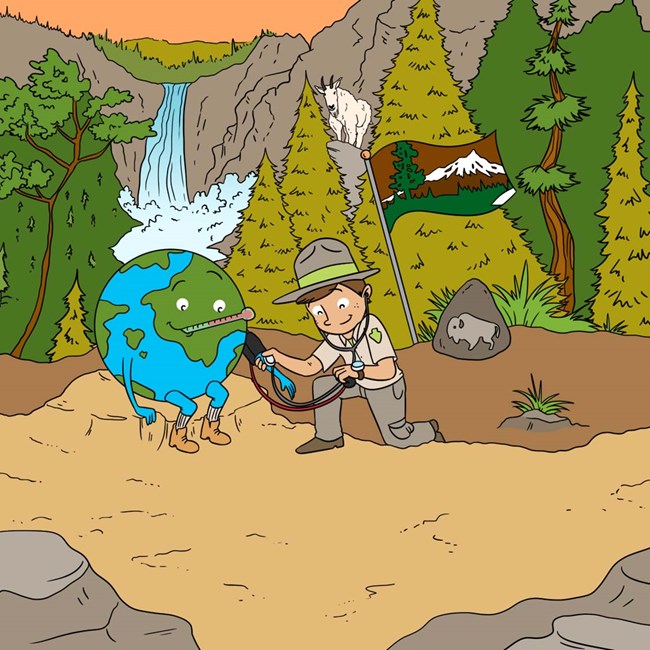
Credit: Frontiers for Young Minds
How do we know if parks are healthy? We measure their vital signs, of course! Across the country, there are 32 inventory and monitoring networks that measure the status and trends of all kinds of park resources. We're learning a lot after years of collecting data.
These articles are a collection, or special issue, of Frontiers for Young Minds, an international online journal of science written for kids and involving kids in the review process. Taking the Pulse of U.S. National Parks presents what we are learning from years of monitoring plants and animals and physical conditions in parks.
Now you can download an eBook of the entire collection of articles! Click the Download eBook button on the collection main page.
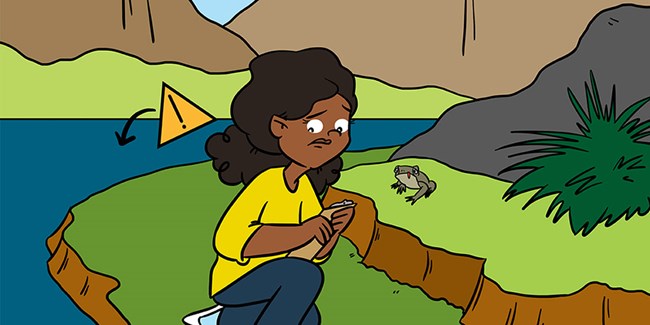
Credit: Frontiers for Young Minds
Ecosystem Concepts
Indicator species reveal environmental health
Sophie Phillips, Martha Merson, Nickolay Hristov, Louise Allen, and Robert Brodman
When looking around outside, many people see reasons to worry about the environment. Often what they notice are the effects of pollution and climate change, which can be harmful to people, wildlife, and the ecosystems where they live. Understanding the condition of all living and non-living things in an ecosystem is important for maintaining a healthy environment. But collecting information on every element in an ecosystem takes time and effort and is not always possible. Luckily, the United States National Park Service scientists know that collecting data on the condition of one species, called an indicator species, can reveal a lot about the well-being of other species in an ecosystem. Based on what they learn from observing and studying indicator species, park managers can make decisions about restoring plants, using chemicals, and posting signs about fishing rules. In Indiana Dunes National Park (Indiana, United States), researchers rely on frogs as indicator species.
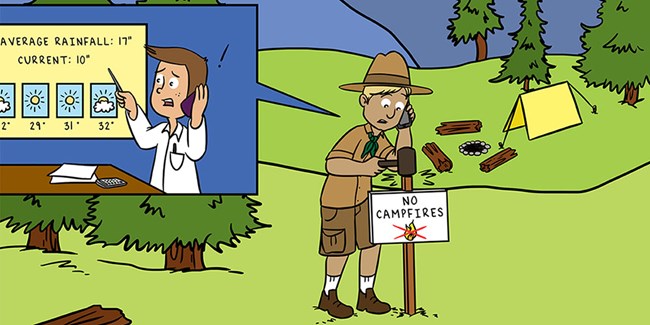
Credit: Frontiers for Young Minds
When nature gets thirsty
Rebecca Weissinger, David Thoma, and Alice Wondrak Biel
Water is the fountain of life. Without water, nothing grows, including us! But not everything in nature can have all the water it needs, all the time. If plants and animals get too thirsty, they get stressed. When nature dries out, dangerous conditions like droughts and wildfires can happen. It is important for national park managers to understand where and when nature is thirsty. As scientists, we track how much water falls as rain and snow. Then we subtract how much water leaves through rivers, groundwater, and evaporation. The leftover water can be used by plants and animals. We compare how much water plants want to how much water is available, so we can know how thirsty plants are. The hotter it is, the faster water disappears. By knowing when and where nature is thirsty, park managers can take actions to help protect parks.
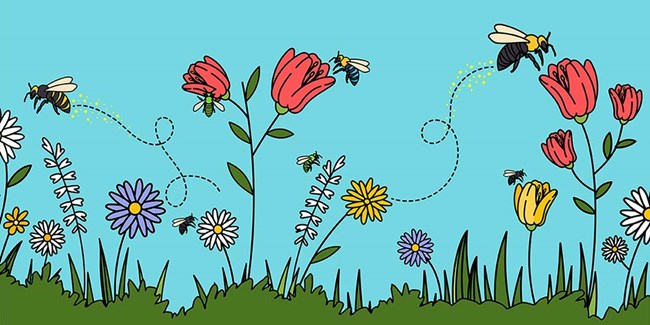
Frontiers for Young Minds
What's the buzz about native bees?
Jessica Rykken
Most plants depend on insects for pollination. Honey bees pollinate many of the foods people eat, but did you know that wild plants, and animals like birds and bears, also depend on pollinators? Native bees are the most diverse and efficient pollinators. Thousands of bee species transport pollen between plants in deserts, forests, mountains, meadows, and many other habitats. This service helps plants reproduce successfully, and the plants provide food and shelter for other animals. Bees are important for keeping our wild landscapes healthy. Scientists are discovering that climate change and other human-caused threats are changing bee populations. Therefore, it is important that we learn more about pollinators in wild places like national parks and that we support bees in our own backyards.
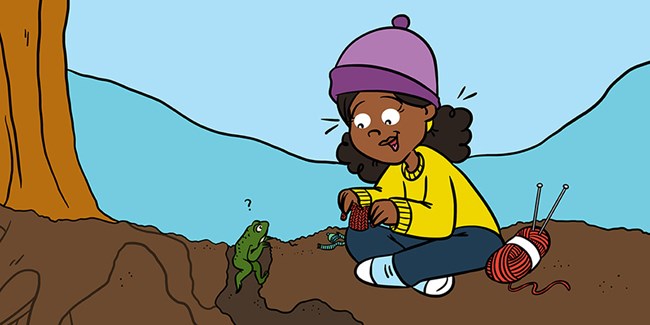
Credit: Frontiers for Young Minds
Do not croak! A story of surviving Yellowstone's frigid winters
Jana Cram, Ashelee Rasmussen, Debra Patla, Andrew Ray, and Charles Peterson
Have you ever wondered how “cold-blooded” animals like amphibians (frogs, toads, and salamanders) survive the winter without fur or feathers to keep them warm? Yellowstone National Park’s amphibians have found ways to stay alive during the cold winter months. These animals have evolved various coping strategies, from burrowing underground, to living in ponds, to tolerating the freezing of much of the water in their bodies. This article will explore the strategies used by several amphibians to survive the winter, including strategies used by the boreal chorus frog, Columbia spotted frog, western toad, and western tiger salamander. Understanding the diverse ways that amphibians survive in their winter habitats helps scientists to recommend ways to protect those habitats, to ensure that amphibians have healthy places to live and reproduce.
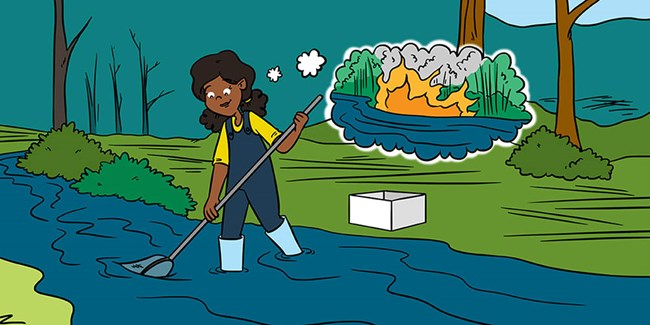
Frontiers for Young Minds
Eric Dinger, Billy Schweiger, and Trey Simmons.
The weird and wonderful variety of bugs that live in streams is more than cool—it is a great scientific tool. The mixture of bugs helps scientists understand water quality, which means whether the water is clean or dirty. Two kinds of tools translate bug variety into measures of stream health. One is called a multimetric index; the other is called an observed-to-expected index. The multimetric index “speaks bug” to us. It uses bug preferences for food and habitat, tolerance for pollution, and other bug attributes to decipher whether a stream is to a bug’s liking. The observed-to-expected index uses scientists’ knowledge of which bugs usually occur in clean water, to predict which should be present in a good-quality stream. Both indices give us the big picture of water quality and help scientists track the health of streams in U.S. national parks.
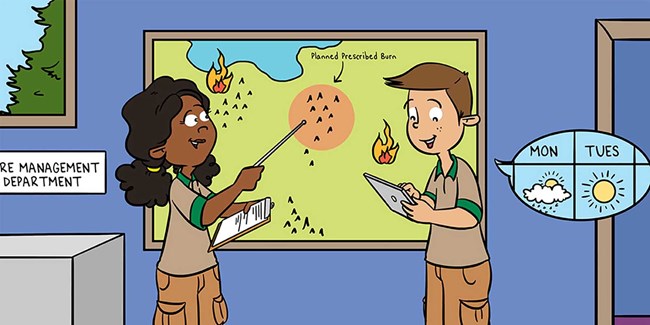
Credit: Frontiers for Young Minds
Rising from the ashes: The role of fires in National Parks
Suzanne Sanders, Linda Mutch, Mark Wasser, Jennifer Barnes, and Stephanie Perles
Fire is a natural and healthy part of many ecosystems, and many plant species rely on it to reproduce. Some species require the actual heat and flames for their seeds to be released and sprout. Other species rely on fire to burn off dried needles and leaves on the ground as well as many of the shrubs and small trees. This opens up the forest and allows more space and light for small plants and trees. While fire is a good thing for many plants and ecosystems, this is not the case everywhere. In areas that get high amounts of rain, ecosystems are not adapted to fire. Human-caused fires in these places can be devastating to the plants there. It is the job of fire managers and ecologists to manage wildfires, make decisions about fire suppression, and decide if additional fires are needed in key ecosystems.
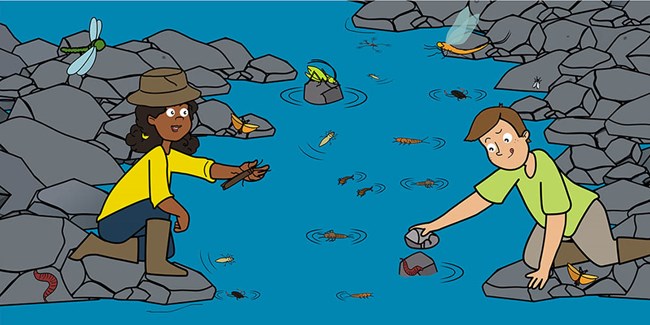
Frontiers for Young Minds
What We're Learning About How Ecosystems Work
The wild and wonderful world of stream bugs
Trey Simmons, Eric Dinger, and Billy Schweiger.
Under the surface of most streams a strange world exists, made up of hundreds of small critters called aquatic invertebrates. “Aquatic” means they live in the water and “invertebrate” means they have no backbones or even skeletons. Some have body parts that look like they came from an alien planet. Some have slippery bodies adapted to rushing stream water. These organisms play many important roles. Some live for up to 7 years and others live for as little as 2 weeks. Some eat slime growing on stream rocks and others eat leaves. Some, like the golden stonefly, even stalk and eat other invertebrates, like a tiger in a jungle. In national parks and around the world, scientists use these insects, worms, leeches, and mites to tell if the water is healthy. We can do this because certain stream invertebrates disappear if water is polluted, or if the stream habitat is degraded.
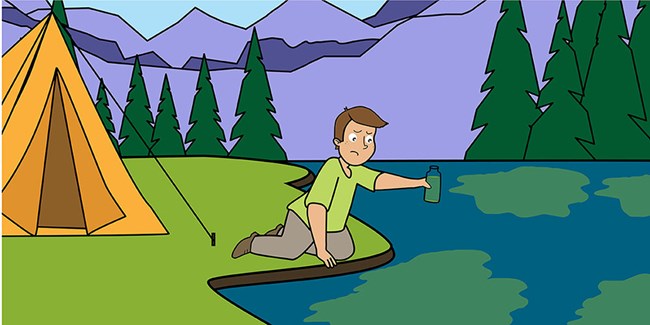
Credit: Frontiers for Young Minds
Nutrients in mountain lakes: How much is too much?
Andrea Heard, James Sickman, and Linda Mutch
Yosemite, Kings Canyon, and Sequoia national parks protect over 1,200 mountain lakes. These lakes provide healthy homes for plants and animals and supply clean water to downstream communities. These clear blue lakes are high up in the mountains, where they receive very low amounts of nutrients from the watershed. Nutrients help living things grow and be healthy. However, human activities from communities upwind are adding nutrients into the air. These nutrients travel on air currents to remote watersheds via rain, snow, and dry particles. They increase lake algae growth, which disrupts the balance of plants and animals. We conducted experiments to determine the amount of nutrients it takes to increase algae growth. We compared these levels to current lake nutrient concentrations and found that over half of the lakes had concentrations that were below the determined early warning point and just under half were at levels of higher concern.
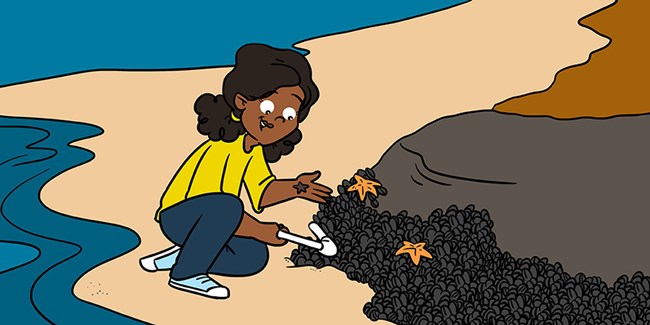
Credit: Frontiers for Young Minds
Diversity and disturbance: How mussels and sea stars strengthen the rocky intertidal community
Elliot Hendry, Karah Ammann, and Eric Dinger
In the rocky intertidal zone, tides and rocks set the stage. Together they create habitat for a diverse community of species adapted to a world both underwater (high tide) and exposed to air (low tide). In some protected areas, like national parks, we study rocky intertidal ecosystems as vital signs of nature’s health. Studying them helps us understand the impact of disturbances, which play an important role in shaping these communities. Some disturbances, like the tides, happen daily. Others, like diseases, might happen once every decade. This article is about how tides and diseases affect two important members of rocky intertidal communities—mussels and sea stars. We explain the roles these organisms play and what happened when ochre sea stars, an important species in these habitats, suffered a major disease outbreak. Last, we emphasize the importance of protecting these vital ecosystems so we can continue to learn about the health of the natural environment.
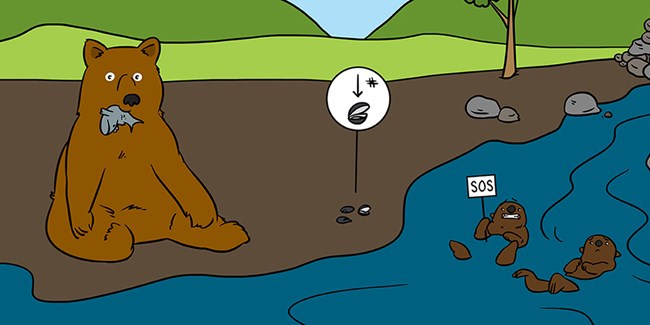
Credit: Frontiers for Young Minds
Where land and sea meet: Brown bears and sea otters
Heather Coletti, Grant Hilderbrand, James Bodkin, Brenda Ballachey, Joy Erlenbach, George Esslinger, Michael Hannam, Kimberly Kloecker, Buck Mangipane, Amy Miller, Daniel Monson, Benjamin Pister, Kelsey Griffin, Kelly Bodkin, and Tom Smith
In Katmai National Park, Alaska, we have seen changes in the number of brown bears and sea otters. The number of animals of a species a habitat can support is called carrying capacity. Even though bears live on land and sea otters live in the ocean, these two mammals share coastal habitats. Bears eat salmon, other fish, plants, clams, and beached whales. Sea otters feed on clams and other marine invertebrates. All these foods are influenced by the ocean. Recently, we have seen fewer bears but more sea otters! What changed? Many things, but several observations point to the ocean. There are fewer salmon, whales, and clams, so bears rely more on plants for food. Fewer clams mean sea otters must work harder to find food. Our studies are helping us to understand how and why carrying capacity for a given species may change over time.
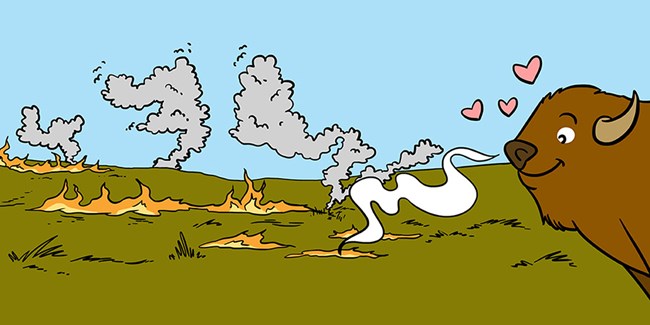
Credit: Frontiers for Young Minds
Eating while the eating's good: How fire creates a magnet for grazing animals
Sherry Leis and Carol Baldwin
Tallgrass prairie is disappearing because farming and development have replaced it. This ecosystem is home to a unique group of plants, animals, and microbial life. The processes of fire, grazing by animals, and drought are important to the tallgrass prairie. They can influence each other and prairie life. For example, pyric-herbivory is the interaction of fire and grazing on the landscape. Burned areas attract herbivores (plant eaters) like a magnet. After fires, plant growth is nutritious and easy to find. Herbivores prefer grazing recently burned areas, creating patches of different habitats that support many other wildlife species, too. You can see pyric-herbivory in action at the Tallgrass Prairie National Preserve, where fire, cattle, and bison are a part of the preserve’s management team! Healthy tallgrass prairie needs both fire and grazing.

Credit: Frontiers for Young Minds
Mangrove madness: What are mangroves and why do we care about them?
Kevin Whelan and Michelle Prats
Mangrove communities are found in tropical regions of the world. They live along coastlines in the intertidal zone, where the land meets the sea. Mangroves provide many ecological services—a fancy term for benefits. They capture valuable sediments flowing into the ocean from streams, lower impacts from harmful substances, support many creatures, and prevent coastline erosion. At the heart of mangrove communities is the mighty mangrove tree. Mangrove trees have a unique system of roots and other structures to help them survive in a salty world. They tolerate regular flooding but can drown if they are under water too long. To adjust to rising sea levels, mangroves can bio-generate or capture materials to create soil. National Park Service scientists are studying this process. By building soil, mangroves capture and store carbon dioxide, which helps fight climate change. Mangroves are important to us all!
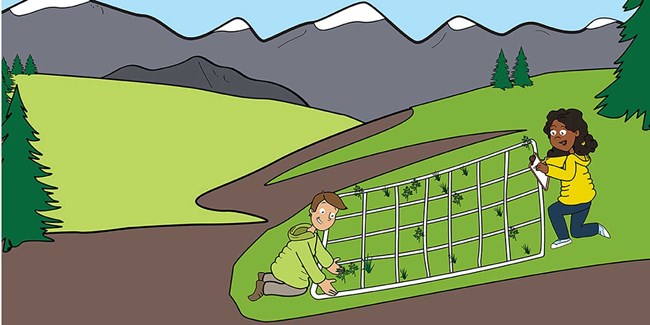
Credit: Frontiers for Young Minds
A recipe for plant diversity in subarctic Alaska
Sarah Stehn and Carl Roland
Hungry for a little plant diversity? Let us mix some up! First, we gather available ingredients—a bit of soil, a few nutrients, and a selection of nearby plants. Then, we add them together, pour them onto a landscape and let our concoction sit. Sound easy enough? But wait… was that soil we used too acidic? Did we add enough liquid? Was our landscape flat or tilted? How can we adjust our recipe to grow the most plant species in one place? As plant ecologists, we travel to remote places in subarctic Alaska to look at which species grow there. At each place, we record the condition of the environment and tally the number of plant species we find. Over 1,000s of visits, we now have a pretty good recipe for cooking up plant diversity! By learning about where plant diversity is high now, we can help protect it into the future.

Credit: Frontiers for Young Minds
Do parks help forests?
John Paul Schmit, Kathryn Miller, Elizabeth Matthews, and Andrejs Brolis
National Parks were created to help protect nature. But does that protection really matter? Are forests inside parks actually any better off than nearby forests outside of parks? How could you even tell? To find out, we studied thousands of trees inside of parks. We measured every tree’s diameter to see how big it was and returned 4 years later to see how they had changed. Then we compared the trees in parks to thousands of other trees that had been measured in similar unprotected forests nearby. It turns out that there are more trees growing in parks, and large trees are much more common. Trees in parks are less likely to die, but due to their large size, they grow more slowly. Parks even have more dead trees and dead wood on the forest floor. All of these things are signs of a healthy forest.
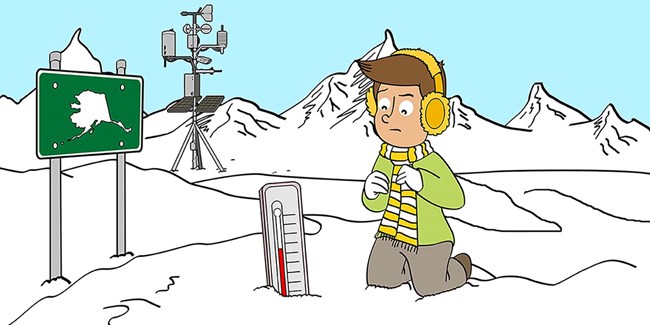
Credit: Frontiers for Young Minds
Climate Change Impacts in Park Ecosystems
Two degrees matters
Pam Sousanes, Ken Hill, and David Swanson
How do you tell if someone is not well? You take the person’s temperature. If it is too warm, something is not quite right. We care about how the weather and climate are changing in Alaska’s national parks, so we continuously take their temperatures. We have dozens of weather stations in remote locations in the northern Alaska parks that run continuously, powered by the sun. Over the past several years, we found that the air and ground temperatures have been warmer than normal. Plants, animals, and people get used to living in their environments. They thrive within an expected temperature range. Things get out of whack when the environment that organisms are accustomed to changes. In northern Alaska, warming of just a few degrees can cause ice to melt and formerly frozen ground to thaw. Once the ground thaws, the ice changes to water and the landscape changes.
Want to learn more? Check out this lesson plan.
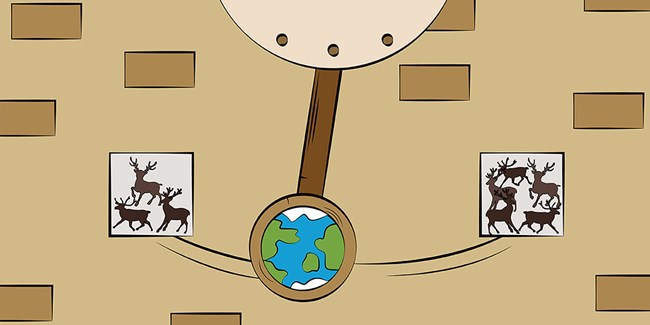
Credit: Frontiers for Young Minds
What goes up must come down: The influence of climate on caribou populations
Kyle Joly
Wildlife populations naturally go up and down. Oscillation is the term used for this pattern of highs (when there are many animals) and lows (when there are few). When the number of births is greater than the number of deaths, then populations grow. If deaths exceed births, populations decline. Caribou in the Arctic have dramatic population oscillations. The number of caribou can grow very high and also decrease to very few. Large-scale, long-lasting weather oscillations are one reason for this pattern. Knowledge of the connection between wildlife populations and climate oscillations is important to help conserve species like caribou and to better understand how climate change will impact wildlife.
Want to learn more? Check out this lesson plan.
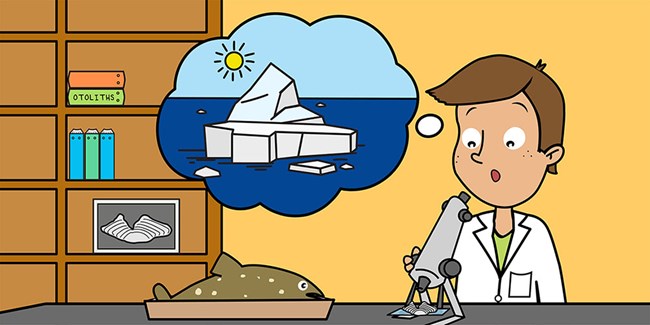
Credit: Frontiers for Young Minds
Fish ear stones offer climate change clues in Alaska lakes
Krista Bartz, Vanessa von Biela, Bryan Black, Daniel Young, Peter van der Sleen, and Christian Zimmerman
Otoliths, also known as ear stones, are small body parts that help fish with hearing and balance. Like tree rings, otoliths form one light and one dark band per year, creating rings. These rings can be measured to understand fish growth. The wider the ring, the greater the growth. In our study, we used otoliths to understand how one fish species—lake trout—responds to rising temperature in the state of Alaska. We found that warmer spring air temperature and earlier lake ice melt were related to faster lake trout growth. This finding is consistent with other studies that link warmer water temperature and earlier lake ice melt to increased plankton in Alaska’s lakes. Together, these findings suggest that climate-driven increases at the bottom of the food web might benefit top predators like lake trout. However, the relationship between warmer temperature and faster growth may not last.
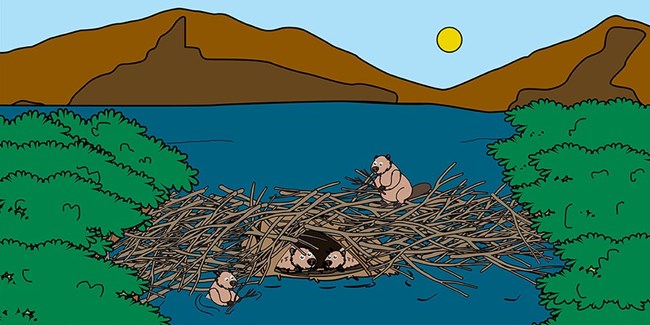
Credit: Frontiers for Young Minds
How beavers are changing Arctic landscapes and Earth's climate
Jonathan O'Donnell, Michael Carey, Brett Poulin, Ken Tape, and Joshua Koch
Beavers build dams that change the way water moves between streams, lakes, and the land. In Alaska, beavers are moving north from the forests into the Arctic tundra. When beavers build dams in the Arctic, they cause frozen soil, called permafrost, to thaw. Scientists are studying how beavers and the thawing of permafrost are impacting streams and rivers in Alaska’s national parks. For example, permafrost thaw from beavers can add harmful substances like mercury to streams. Mercury can be taken up by stream food webs, including fish, which then become unhealthy to eat. Permafrost thaw can also move carbon (from dead plants) to beaver ponds. When this carbon decomposes, it can be released from beaver ponds into the air as greenhouse gases, which cause Earth’s climate to warm. Scientists are trying to keep up with these busy beavers to better understand how they are changing Arctic landscapes and Earth’s climate.

Credit: Frontiers for Young Minds
Permafrost and draining lakes in Arctic Alaska
David Swanson
In the Arctic, the ground is frozen most of the year. Only the top layer of soil thaws each summer. This frozen ground, called permafrost, contains a lot of frozen water (ice). There are many small lakes in the Arctic, in low spots formed from melted ice. But melting ice does not just create lakes, it can destroy them too. Melting permafrost can create gullies that let the water drain out of a lake. Most lakes in the Arctic are far from where people live, so we watch them using pictures taken from satellites. Recently, we have seen the water drain out of many lakes, which can affect plants and animals. We measure the number and size of drained lakes caused by thawing permafrost to understand how the Arctic is changing.
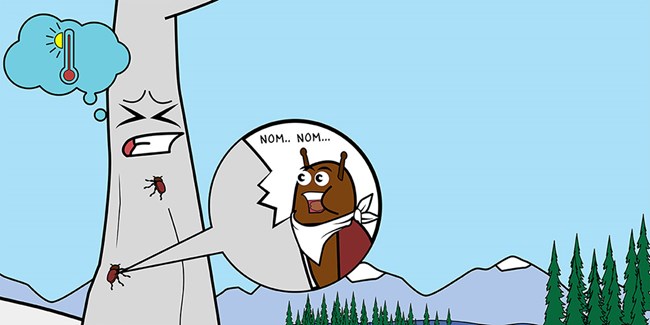
Credit: Frontiers for Young Minds
Trouble in the forest: Whitebark pine trees, mountain pine beetles, and climate change
Alzada Roche, Erin Shanahan, and Jonathan Nesmith
Have you ever hiked up a mountain and felt a frosty wind blowing across your face? You might need to button up your jacket to visit this place, but here, whitebark pine trees are right at home. Whitebark pines thrive in the highest forests of western North America. In these environments, whitebark pines help other, less-hardy species to establish, grow, and survive. For this pine, chilly mountaintops provide a refuge from insects, disease, and competition with other trees. Yet as our climate changes, whitebark pines no longer have the cold on their side. They are dying at alarming rates, and one of the biggest killers is a tiny bark beetle. How is climate change helping this little insect munch through huge swaths of forest? National Park Service scientists use long-term monitoring studies to unravel this complicated relationship. This information guides resource managers entrusted with protecting whitebark pines.

Credit: Frontiers for Young Minds
How We Study Wildlife in Parks and What We're Learning
Monitoring the migrators: Tracking the animals passing through our parks
Thomas Rodhouse and Sonya Daw
Migrating animals are good at making long trips between seasons. These trips can be dangerous, and scientists monitor migrators in United States National Parks to help detect dangers and find solutions. However, migrators are challenging to monitor. Sometimes they only stay in a park for a few days. This might require a scramble to find them during the proper season, using specialized techniques. It is worth the effort! Birds are some of the best-known migrators, and birdwatchers come to parks every spring to help count them. Migrating butterflies and bats are less well-known and require more effort to monitor. Monarch butterflies are tagged with special numbered stickers, and bat calls are recorded at night with special computers. These monitoring activities reveal where, when, and how many migrators occur in parks. If we discover through monitoring that they are in decline, we can sound the alarm and get help for these special animals.

Frontiers for Young Minds
Millions of monarch butterflies and the quest to count them
Sophie Phillips, Martha Merson, Louise Allen, and Nickolay Hristov
Monarchs are capable of amazing feats! They transition from caterpillars to beautiful butterflies. During migration, they fly for thousands of miles—from the northern part of the United States and southern Canada to Mexico. But monarch butterflies are in trouble. In the past 25 years, citizens and scientists have reported fewer and fewer of them. There were less than half as many monarchs in 2020 as in 2019. Parks across the United States, like Rocky Mountain and Indiana Dunes National Parks, host the monarchs along their migration paths. The park rangers are helping scientists track monarchs through “capture, tag, and release.” With this method, anyone who sees a tagged butterfly can report when and where they saw it. By tracking monarchs along their migration paths, we expect to learn where they run into problems. Scientists are also using new technology to count monarchs in their winter habitats.
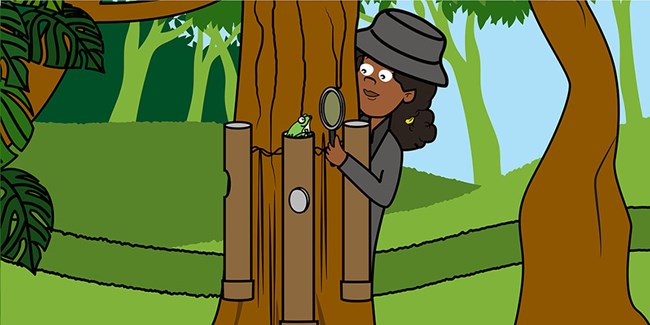
Credit: Frontiers for Young Minds
Scientists spy on treefrogs using plastic pipes in trees
Carolyn Carlson and Jane Carlson
Have you ever spied on a treefrog? These nocturnal creatures can be hard to observe, cloaking their lives in mystery. They hatch as legless swimmers but quickly transform into adults with camouflaged skin for daytime hiding and sticky toepads for hunting in tree branches by night. Yet even the most secretive, high-climbing treefrog cannot escape from pollution, new enemies, and habitat loss. Scientists want to know how treefrogs are coping with these threats, so we spy on them in a clever way: we hang small plastic pipes from trees, which mimic the dark cavities where treefrogs love to rest. Since 2011, we have counted treefrogs inside thousands of pipes, yet with so many mysteries, our work will continue for years. One pipe at a time, treefrogs are sharing their secrets about which threats harm them most, helping us better protect and manage the beautiful trees and waters they call home.
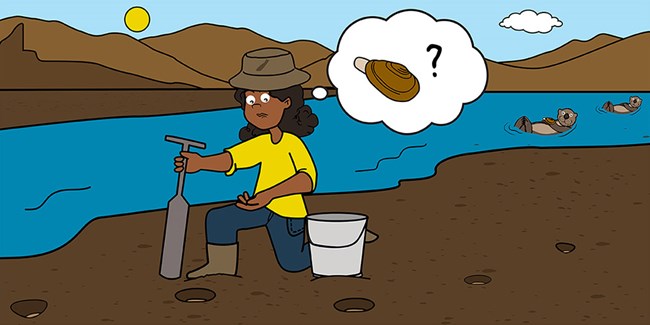
Credit: Frontiers for Young Minds
The mysterious case of the missing razor clams
Heather Coletti, Lizabeth Bowen, Brenda Ballachey, Tammy Wilson, Shannon Watrs, Michael Booz, Katrin Counihan, Tuula Hollmen, and Benjamin Pister
Oceans are changing and these changes are affecting the animals that live there. Animals respond differently to changes in water temperature, food availability, and contaminants. Those responses can be seen in their genes. A technique called transcriptomics allows scientists to see the response of an animal’s genes to its environment. We used transcriptomics to compare two populations of Pacific razor clams in Alaska (United States): one that has lots of clams and one that used to have lots but does not anymore. We were surprised when we did not find any differences in their gene responses! So, we had to think about what else might be influencing the number of clams in these two populations. As we “dug” for answers, we found out that there are differences between the populations that do not influence their genes but may impact their numbers, such as being eaten by predators.

Credit: Frontiers for Young Minds
Cracking the mystery of Crater Lake's unique newts
Andrew Ray, Stephen Spear, Scott Girdner, and David Hering
Why does Earth have such an incredible variety of plants and animals? One little newt helps tell the story. In Crater Lake, the world’s clearest lake, a uniquely colored newt was discovered. Early explorers named it the Mazama newt. For more than 100 years, the newt has been considered a subspecies of the more common rough-skinned newt. A “subspecies” refers to a collection of animals or plants that can interbreed but can often be separated from other individuals of the same species by appearance. Nobody knew exactly how unique the Mazama newt was until scientists took another look. Using a mix of clues, like DNA, skin color, and even poison levels, scientists are cracking the mystery of how the Mazama newt differs from its neighbors. Learning about the newt’s unique characteristics and about other members of the Crater Lake ecosystem is important for protecting biodiversity and lake health.
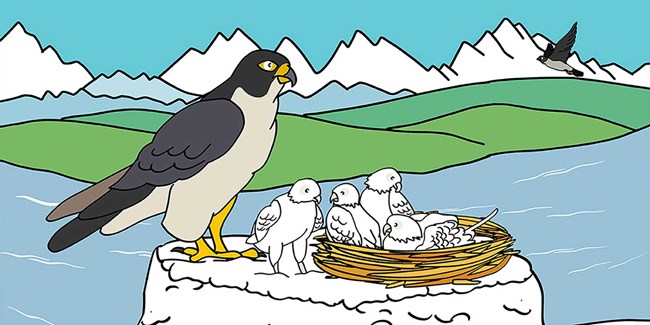
Credit: Frontiers for Young Minds
The recovery of the American peregrine falcon in Alaska
David Payer and Melanie Flamme
American Peregrine Falcons nesting along Alaska’s upper Yukon River have been studied for nearly 50 years. Peregrine populations decreased in the 1960s because widespread use of the insecticide DDT caused their eggshells to thin. Thin eggshells meant that eggs crushed easily in the nest, which reduced the number of baby birds produced. Eventually, Peregrine Falcons were listed as endangered under the Endangered Species Act in the United States (U.S.). After the U.S. banned the use of DDT, the U.S. Fish and Wildlife Service, National Park Service, and others helped Peregrine Falcons recover. Today, upper Yukon River Peregrine Falcons have rebounded and are thriving. The Peregrine Falcon’s recovery in the U.S. is a shining success story of the Endangered Species Act, although climate change and other pollutants create continuing challenges for the species.
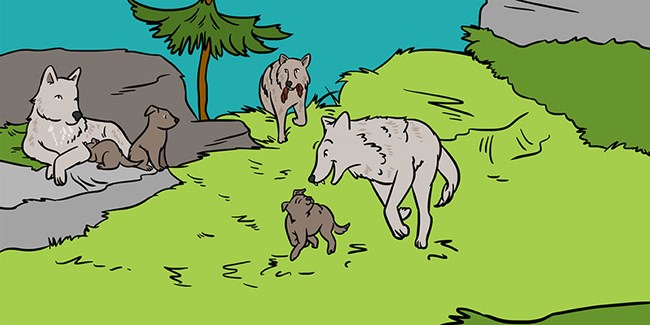
Frontiers for Young Minds
It takes a pack to raise a pup
Mathew Sorum, Jordan Pruszenski, and Bridget Borg
Wolves are important to keep ecosystems healthy. For wolf populations to thrive, pups need to survive into adulthood. Wolf pups can be harmed, even killed, by wolves from outside their pack. To protect the pups, some wolves in the pack must stay at the den and guard the pups. But some of the adults must leave the den sometimes, to hunt for food and to keep other wolves out of the pack’s territory. By monitoring and studying wolves for many years across North America and in Alaska’s national parks, we are learning how wolves divide these tasks. We know that the mother wolves care for their pups for the first several weeks while nursing, but once the pups no longer need milk, all pack members share in taking care of the pups. We have come to understand that all wolves are important to the success of the pack.
Tags
- acadia national park
- arches national park
- bering land bridge national preserve
- biscayne national park
- cape krusenstern national monument
- crater lake national park
- denali national park & preserve
- gates of the arctic national park & preserve
- glacier national park
- golden gate national recreation area
- grand teton national park
- great smoky mountains national park
- indiana dunes national park
- isle royale national park
- jean lafitte national historical park and preserve
- katmai national park & preserve
- kobuk valley national park
- lake clark national park & preserve
- noatak national preserve
- redwood national and state parks
- rocky mountain national park
- saratoga national historical park
- sequoia & kings canyon national parks
- shenandoah national park
- tallgrass prairie national preserve
- virgin islands national park
- voyageurs national park
- whiskeytown national recreation area
- wrangell - st elias national park & preserve
- yellowstone national park
- yosemite national park
- yukon - charley rivers national preserve
- science
- youth programming
- education
- educational
- childrens activities
- kids
- kids activity
- science education
- every kid outdoors
- im
- monitoring
- inventory and monitoring
- inventory and monitoring division
